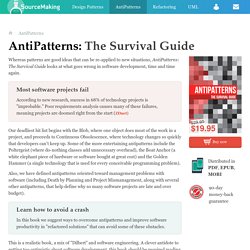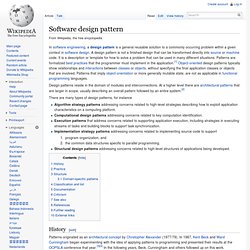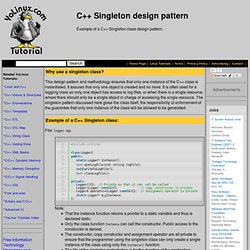

AntiPatterns: The Survival Guide. Whereas patterns are good ideas that can be re-applied to new situations, AntiPatterns: The Survival Guide looks at what goes wrong in software development, time and time again.

Most software projects fail According to new research, success in 68% of technology projects is "improbable. " Poor requirements analysis causes many of these failures, meaning projects are doomed right from the start (ZDnet) Our deadliest hit list begins with the Blob, where one object does most of the work in a project, and proceeds to Continuous Obsolescence, where technology changes so quickly that developers can't keep up. Some of the more entertaining antipatterns include the Poltergeist (where do-nothing classes add unnecessary overhead), the Boat Anchor (a white elephant piece of hardware or software bought at great cost) and the Golden Hammer (a single technology that is used for every conceivable programming problem).
Design pattern (computer science) There are many types of design patterns, for instance Algorithm strategy patterns addressing concerns related to high-level strategies describing how to exploit application characteristics on a computing platform.Computational design patterns addressing concerns related to key computation identification.Execution patterns that address concerns related to supporting application execution, including strategies in executing streams of tasks and building blocks to support task synchronization.Implementation strategy patterns addressing concerns related to implementing source code to support program organization, andthe common data structures specific to parallel programming.Structural design patterns addressing concerns related to high-level structures of applications being developed.

History[edit] Although design patterns have been applied practically for a long time, formalization of the concept of design patterns languished for several years.[5] Practice[edit] Structure[edit] Criticism[edit] Huston Design Patterns. Design Patterns and Refactoring. Design Patterns. In software engineering, a design pattern is a general repeatable solution to a commonly occurring problem in software design. A design pattern isn't a finished design that can be transformed directly into code. It is a description or template for how to solve a problem that can be used in many different situations.
Uses of Design Patterns Design patterns can speed up the development process by providing tested, proven development paradigms. Effective software design requires considering issues that may not become visible until later in the implementation. Often, people only understand how to apply certain software design techniques to certain problems. In addition, patterns allow developers to communicate using well-known, well understood names for software interactions. Machine Objects - Hierarchical state machines in C++ 1 Introduction The Machine Objects class library allows the creation of state machines based on the "State" design pattern in plain C++.

It extends the pattern with the option to create hierarchical state machines, making it possible to convert the popular UML statechart notation to working code in a straightforward way. Other features are entry and exit actions, state histories and state variables. The "just show me code" link to an example state machine: Microwave 2 Motivation In my experience as software developer I have found the State design pattern to be very useful. Another important property that stems from this simplicity is orthogonality: the pattern can be combined with other design elements, patterns and idioms in arbitrary ways. In contrast stand tool supported approaches to state machine creation (of which there is no shortage). Unfortunately the "State" pattern is limited in scope because it does not allow for hierarchical state machines.
Linux Tutorial - C++ Singleton design pattern. This design pattern and methodology ensures that only one instance of the C++ class is instantiated.

It assures that only one object is created and no more. It is often used for a logging class so only one object has access to log files, or when there is a single resource, where there should only be a single object in charge of accessing the single resource. The singleton pattern discussed here gives the class itself, the responsibility of enforcement of the guarantee that only one instance of the class will be allowed to be generated. File: logger.hpp Note: That the instance function returns a pointer to a static variable and thus is declared static.
File: logger.cpp Usage: In this example the base class enforces a singleton pattern. File: base.hpp File: base.cpp File: derived.hpp File: derived.cpp File: main.cpp Compile: g++ main.cpp derived.cpp base.cpp Results: a.out Note that the function calls are static calls to their global names using the scope resolution operator. Singleton pattern in C++